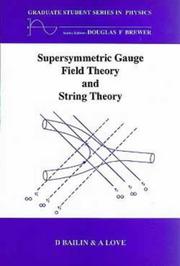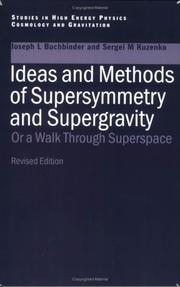| Listing 1 - 3 of 3 |
Sort by
|

ISBN: 0429176147 1482268736 0585307334 9781482268737 9780429176142 0750306726 Year: 2018 Publisher: Boca Raton, Florida ; London ; New York : CRC Press,
Abstract | Keywords | Export | Availability | Bookmark
 Loading...
Loading...Choose an application
- Reference Manager
- EndNote
- RefWorks (Direct export to RefWorks)
A unified theory embracing all physical phenomena is a major goal of theoretical physics. In the early 1980s, many physicists looked to eleven-dimensional supergravity in the hope that it might provide that elusive superunified theory. In 1984 supergravity was knocked off its pedestal by ten-dimensional superstrings, one-dimensional objects whose vibrational modes represent the elementary particles. Superstrings provided a perturbative finite theory of gravity which, after compactification to four spacetime dimensions, seemed in principle capable of explaining the Standard Model. Despite these major successes, however, nagging doubts persisted about superstrings. Then in 1987 and 1992 the elementary supermembrane and its dual partner, the solitonic superfivebrane, were discovered. These are supersymmetric extended objects with respectively two and five dimensions moving in an eleven-dimensional spacetime. Over the period since 1996, perturbative superstrings have been superseded by a new nonperturbative called M-theory, which describes supermembranes and superfivebranes, subsumes string theories, and has as its low-energy limit, eleven-dimensional supergravity. M-theory represents the most exciting development in the subject since 1984 when the superstring revolution first burst on the scene. The first book devoted to M-theory, The World in Eleven Dimensions: Supergravity, Supermembranes and M-Theory brings together seminal papers that have shaped our current understanding of this eleven-dimensional world, from supergravity through supermembranes to M-theory. Each chapter includes commentaries intended to explain the importance of these papers and to place them in a wider perspective. Each chapter also has an extensive bibliography. The book is of interest to researchers and postgraduate students in particle physics, mathematical physics, gravitation, and cosmology.
Supergravity. --- Superunified theories --- Unified theories --- General relativity (Physics) --- Quantum theory --- Supersymmetry --- Nuclear physics --- Physics

ISBN: 0750302674 0750302682 0367805804 1420050826 9780750302678 9780750302685 Year: 1994 Publisher: [Place of publication not identified] : CRC Press,
Abstract | Keywords | Export | Availability | Bookmark
 Loading...
Loading...Choose an application
- Reference Manager
- EndNote
- RefWorks (Direct export to RefWorks)
Designed as a sequel to the authors' Introduction to Gauge Field Theory, Supersymmetric Gauge Field Theory and String Theory introduces first-year graduate students to supersymmetric theories, including supergravity and superstring theories. Starting with the necessary background in quantum field theory, the book covers the three key topics of high-energy physics. The emphasis is on practical calculations rather than abstract generalities or phenomenological results. Where possible, the authors show how to calculate, connecting the theoretical with the phenomenological. While the field continues to advance and grow, this book addresses the basic theory at the core and will likely remain relevant even if more advanced ideas change.
Supersymmetry --- Supergravity --- Superstring theories --- 530.19 --- Unified theories --- Particles (Nuclear physics) --- Symmetry (Physics) --- Superstrings (Nuclear physics) --- Theories, Superstring --- String models --- Superunified theories --- General relativity (Physics) --- Quantum theory --- Fundamental functions in general. Potential. Gradient. Intensity. Capacity etc. --- Supergravity. --- Superstring theories. --- Supersymmetry. --- 530.19 Fundamental functions in general. Potential. Gradient. Intensity. Capacity etc. --- Fundamental functions in general. Potential. Gradient. Intensity. Capacity etc --- Nuclear physics

ISBN: 0367802538 058530663X 1420050516 9781420050516 9780367802530 0750305061 Year: 1998 Publisher: Taylor & Francis
Abstract | Keywords | Export | Availability | Bookmark
 Loading...
Loading...Choose an application
- Reference Manager
- EndNote
- RefWorks (Direct export to RefWorks)
Ideas and Methods of Supersymmetry and Supergravity: Or a Walk Through Superspace provides a comprehensive, detailed, and self-contained account of four dimensional simple supersymmetry and supergravity. Throughout the book, the authors cultivate their material in detail with calculations and full discussions of the fundamental ideas and motivations. They develop the subject in its superfield formulations but where appropriate for illustration, analogy, and comparison with conventional field theory, they use the component formulation. The book discusses many subjects that, until now, can only be found in the research literature. In addition, it presents a plethora of new results. Combining classical and quantum field theory with group theory, differential geometry, and algebra, the book begins with a solid mathematical background that is used in the rest of the book. The next chapter covers algebraic aspects of supersymmetry and the concepts of superspace and superfield. In the following chapters, the book presents classical and quantum superfield theory and the superfield formulation of supergravity. A synthesis of results and methods developed in the book, the final chapter concludes with the theory of effective action in curved superspaces. After studying this book, readers should be well prepared to pursue independent research in any area of supersymmetry and supergravity. It will be an indispensable source of reference for advanced graduate students, postdoctoral faculty, and researchers involved in quantum field theory, high energy physics, gravity theory, mathematical physics, and applied mathematics.
Supersymmetry. --- Supergravity. --- Quantum field theory. --- Supersymmetry --- Supergravity --- Quantum field theory --- Atomic Physics --- Physics --- Physical Sciences & Mathematics --- Relativistic quantum field theory --- Field theory (Physics) --- Quantum theory --- Relativity (Physics) --- Superunified theories --- Unified theories --- General relativity (Physics) --- Particles (Nuclear physics) --- Symmetry (Physics) --- Astrophysics --- Nuclear physics
| Listing 1 - 3 of 3 |
Sort by
|

 Search
Search Feedback
Feedback About
About Help
Help News
News